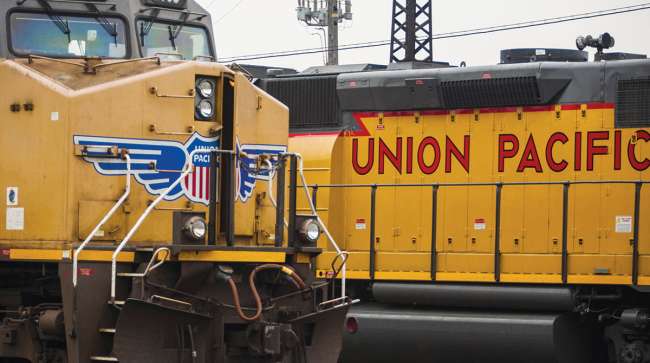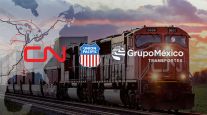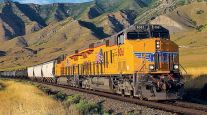Senior Reporter
Union Pacific Reports Strong Q1 Earnings

[Stay on top of transportation news: Get TTNews in your inbox.]
While Union Pacific Corp. delivered first-quarter financial results that outpaced Wall Street expectations, talk of service disruptions across its rail network and those of its competitors was top of mind among company executives who soon must answer to the Surface Transportation Board about those delays.
“Operationally, we did not meet expectations, which is having an impact on our customers,” CEO Lance Fritz said during an April 21 conference call to discuss the company’s quarterly results. “We are taking actions to improve resource utilization, increase crews and locomotives where needed, and reduce freight car inventory levels to restore fluidity.”
The Omaha, Neb.-based Class I freight railroad said first-quarter net income soared 22% to $1.63 billion, or $2.58 a share, compared with $1.34 billion, or $2.01, a year ago.
Union Pacific reports first quarter 2022 results. $UNP https://t.co/VL98vafCkh — Union Pacific (@UnionPacific) April 21, 2022
Operating revenue increased 17% to $5.86 billion compared with $5 billion a year ago.
The average estimate of analysts surveyed by Zacks Investment Research was for $2.55 per share and revenue of $5.81 billion.
Company officials stressed the rail network suffered from serious service problems during the end of 2021 and well into the quarter.
The Surface Transportation Board, which regulates freight and passenger rail, is set to hold a two-day public hearing in Washington April 26-27 with rail leaders on what the STB said are “urgent issues in freight rail service.”
The STB has ordered officials from BNSF Railway, CSX Transportation, Norfolk Southern and Union Pacific to appear at the hearing.
Numerous rail customers, particularly in agriculture, have complained that the difficulties the Class I railroads are dealing with are impacting their operations, especially when it comes to obtaining enough chemicals and fertilizer for the spring planting season.

Transport Topics' Seth Clevenger and Marissa Gamache take you through the process of determining North America’s largest 3PLs in the expanded Transport Topics Top 100 Logistics Companies list. Tune in above or by going to RoadSigns.TTNews.com.
Some customers contend that the railroads cut far too many employees because of their ongoing drive to make the operations more efficient and later the COVID-19 pandemic, when thousands of railroad jobs were lost.
The ongoing operational issues, and how Union Pacific plans to improve its overall service to its customer base dominated much of the discussion with company officials, even as the railroad’s finances dramatically improved.
“What’s happening right now is, I’ll blame it on us, and shame on us,” Fritz said. “We did not have the crew availability for when something went wrong to over-resource for a short period of time and get it (the freight) out of the network. That’s a tough situation to be in and we have already learned that lesson.”
Union Pacific’s operating ratio improved to a first-quarter record of 59.4 compared with 60.1 in the same period a year ago.
Operating ratio measures a company’s expenses as a percentage of revenue and determines efficiency. The lower the ratio, the more ability the company has to make a profit.
Earlier this month Union Pacific sent a letter to its customers outlining what the railroad said were “numerous service problems” and announced a plan to resolve the outstanding issues as soon as possible. The railroad said in the quarter it has already added 50 new locomotives and plans to bring another 100 into its network, and it is aggressively hiring new employees.
“We are facing a tight labor market. As I’ve noted before, we are recruiting heavily to alleviate crew shortages in certain locations and have modified our recruiting strategies to attract more applicants,” wrote Kenny Rocker, executive vice president of sales and marketing. “We are aggressively hiring and streamlined our onboarding process to get new hires on the job faster. We have 450 employees currently in training to graduate in early summer with more in the pipeline. Additionally, we relocated approximately 80 crew members to support crew demand in specific locations across the system.”
The railroad said it plans to hire 100 to 120 new employees a month, or more than 1,400 a year, especially conductors and engineers.
To recruit more employees, Union Pacific changed its hiring process and began what it calls a “second-chance hiring” program, hiring nonviolent felons, who have completed their sentences in the criminal justice system. The company said that effort is “showing great promise.”
The program is now underway in Houston, Chicago, Los Angeles and the railroad city of North Platte, Neb.
Want more news? Listen to today's daily briefing above or go here for more info
Union Pacific reported revenue increases across its 10 business divisions.
Grain products increased 14% to $877 million from $766 million.
Fertilizer shipments were up 6% to $180 million from $170 million.
Food and refrigerated cargo climbed 14% to $267 million from $235 million.
Coal and renewable energy products soared 49% to $508 million from $341 million.
Industrial chemicals and plastics climbed 20% to $520 million from $435 million.
Metals and minerals moved up 29% to $485 million from $375 million.
Forest products showed a 15% increase to $364 million from $316 million.
Energy and specialized markets climbed 4% to $552 million from $530 million.
Automotive shipments increased 12% to $501 million from $447 million.
Intermodal freight showed a 15% improvement to $1.18 billion from $1.03 billion.




